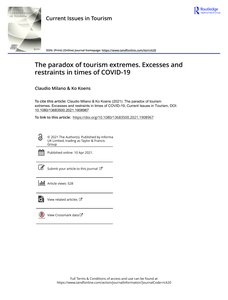This paper seeks to highlight underlying issues of the tourism system that have led to tourism extremes of too much or too little tourism. Five phases are recognized that reflect different ways of dealing with too much tourism over time, after which the impact of a sudden lack of tourism is investigated in light of future renewal processes. This discussion highlights the remarkable capacity of the tourism industry to adjust to rapidly changing circumstances and crises, even when these cause anguish to individuals and within societies at large. The paper thus seeks to contextualize the current discussions regarding the transformation of tourism post COVID-19. It highlights the complexity of changing a tourism that multiple stakeholders depend on or have grown accustomed to. To come to a more balanced tourism, it is necessary to not only come up with alternative visions and strategies, but also to engage with the political economy nature of tourism development. A future research agenda should therefore also discuss facets of entangled power, social exclusion, inequalities and class differences to come to new reference points of what actually constitutes a more inclusive tourism success.
MULTIFILE

In Malaysia, a country that ranks among the world's most recognised medical tourism destinations, medical tourism is identified as a potential economic growth engine for both medical and non-medical sectors. A state-level analysis of economic impacts is important, given differences between states in economic profiles and numbers, origins, and expenditure of medical tourists. We applied input-output (I-O) analysis, based on state-specific I-O data and disaggregated foreign patient data. The analysis includes nine of Malaysia's states. In 2007, these states were visited by 341,288 foreign patients, who generated MYR1,313.4m ($372.3m) output, MYR468.6m ($132.8m) in value added, and over 19,000 jobs. Impacts related to non-medical expenditure are more substantial than impacts related to medical expenditure, and indirect impacts are a substantial part of total impacts. We discuss management and policy responses and formulate recommendations for data collection.
LINK